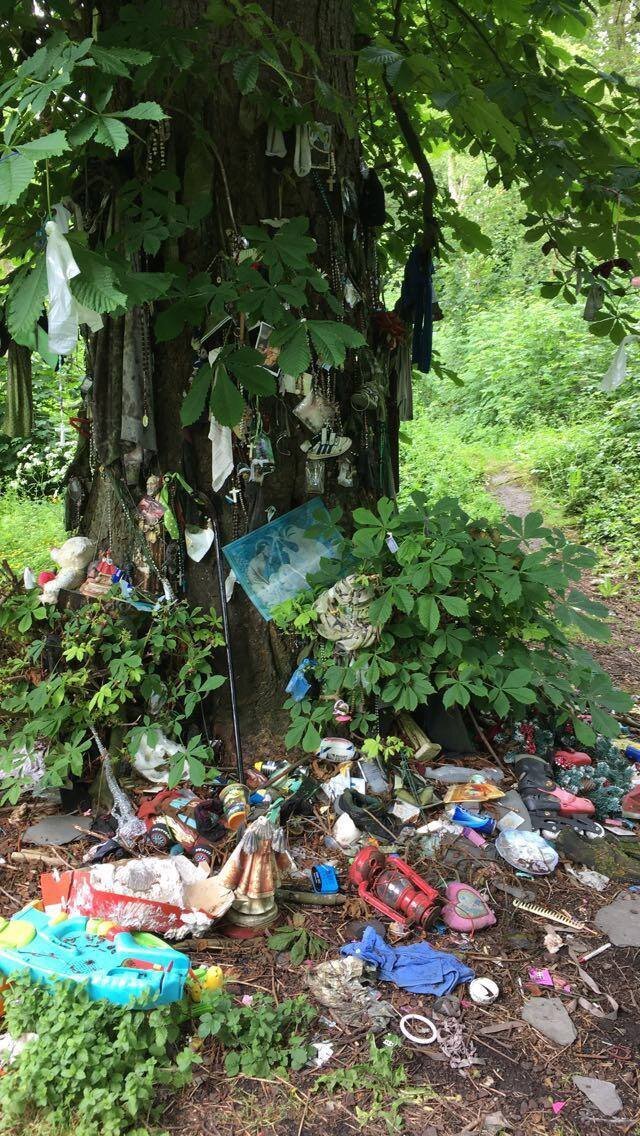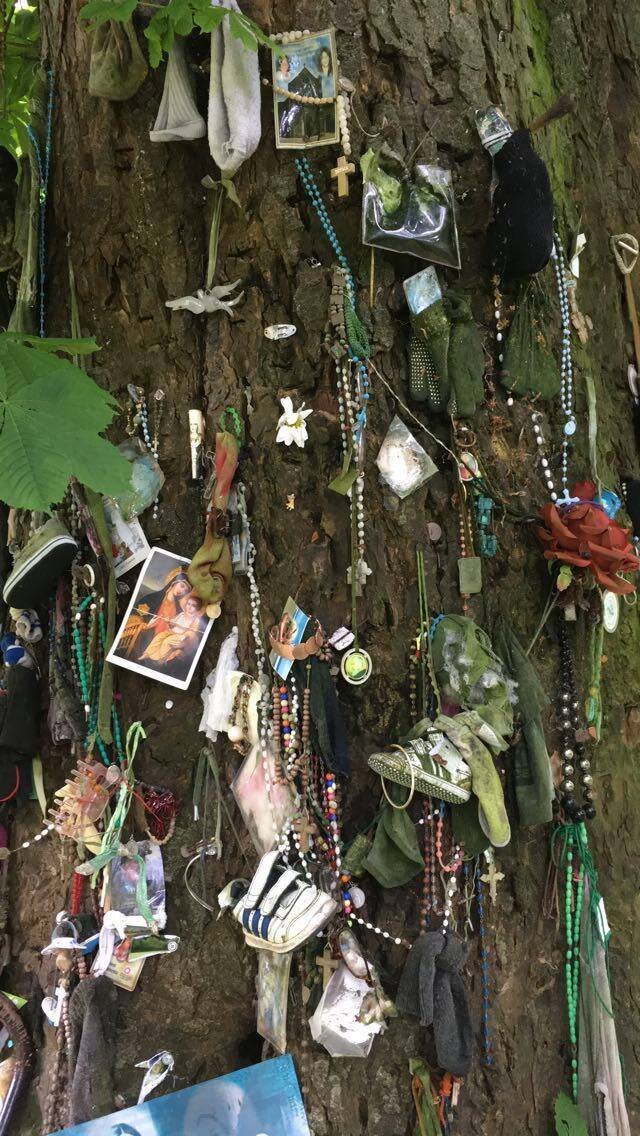Weighted Branches: Wishing Trees, Holy Wells, and Vibrant Matter
St. Brendan's Holy Tree in Clonfert, Galway. Author Credit.
It is idle to fault a net for having holes, writes Maggie Nelson. In this way you can have your empty church with a dirt floor swept clean of dirt and your spectacular stained glass gleaming by the cathedral rafters, both. Because nothing you say can fuck up the space for God.
In Clonfert, County Galway, Ireland, I’m standing in an ancient grove bewitched by a horse-chestnut tree. Its intricate roots sprawl across dark peat, its boughs dutifully low, shuttered with crackling, weathered bark. It bristles in full ornamentation: the trunk is wreathed in Barbies® and plastic dinosaurs, the branches strung with baby socks and toddler’s trainers, and holes in the barky rind are stuffed with inhalers and hospital bracelets.
My shoe just touches a headless statue of the Child of Prague, still a common sight in an Irish—and no longer always Catholic—front yard the night before a parent sees their son or daughter married. I spy a prayer card of Padre Pio, whose time in the rain has left his famous beard an inky squelch. Decades of rosaries in snowy white, bright turquoise, and rosy pink sway from branches and snake through the dirt. Tiny sculptures of the Holy Family guard the roots of the tree while visions of Mother Mary—printed, ceramic, plastic, glass, on medallions—festoon the tree on all sides.
We—the tree, the memoralia, and I—stand where St. Brendan the Navigator founded a monastery some 1400 years before. In this thicket once stood a holy well (which number over 3000 in Ireland), since desecrated by a dog who drowned in its waters. Another well was dug nearby to replace it, only to be sullied some time later when two impish boys crawled into an overhanging ash tree and urinated into it. Its final replacement, tucked somewhere here under the emerald foliage, was neglected over time as this neighboring horse-chestnut began to accrue a patina of holiness.
St. Brigid's Holy Well in Kildare. Photo credit to Jim Dempsey. Trees close to holy wells in Ireland are often covered in votive offerings that may not fit or are not traditionally lain on the stones.
For centuries people have come to this trunk directly to pray for the alleviation of physical ailments, with precatory deposits to secure their petitions. In recent times, this “Wishing Tree” has served as a site intended to help heal sick children. The hair-ties and action figures, then, represent the humans for whom their troubled families seek aid.
Recently, conservation activists in Ireland have resisted the practice of hanging, nailing, or stuffing trees with non biodegradable offerings. One group in 2019, horrified at the practice on some Wishing Trees on the Hill of Tara, commented that “one [of them] has toppled over, the burden of human ‘prayers’ lying on the ground along with it, roots exposed . . . the message from the Trees is Loud and Clear, ‘WE DON’T WANT YOUR BURDENS!’” In 2014, a comment on an archaeology blog about St. Brendan’s tree expressed the wish that people would choose items that would soon disintegrate: “when do socks, car fresheners, lighters etc. stop being offerings and become litter?”
To the scholar of religion, the question is precisely the inverse: when do underwear, inhalers, and Barbies stop being litter and become offerings?
You may not know their names, but many people have made visible the gritty, raw, dirty aspect of their needs. For some, it means peeling off worn undergarments and stringing them to the tree in the desperate hope of effecting change. A child’s pair of striped pink underwear dangling from a low branch calls to attention the weight of the transient in the face of intransigent circumstances. This willful proximity of hope to dirt—interfacing rosaries with broken lighters on caked peat—returns us to Maggie Nelson’s words. Sometimes you have none of the clerestory sapphire light and only earthen floors to sweep yourself clean; sometimes you only have a car air freshener and the pressing reality of an ill child.
In whatever way you manifest your burdens—in this case on dirt floors under branches weighted by soiled clothes—nothing you can say can break the holy power of gathering for a mother whose child is dying. Like Michelangelo’s marbled Mary who clutches her robes and dead son as she greets visitors to St. Peter’s in Rome, the action of mournful collection and arrangement is a form of gripping reality. No wonder the Holy Virgin abounds here.
St. Brendan's Holy Tree in Clonfert, Galway. Author Credit.
If you’ve mourned someone, you know that their possessions become heavy; they weigh our tender boughs down to the earth. St. Brendan’s tree is a living testament to the abundant presence of hard realities of what it means to be living. To touch the postural drainage oxygen mask of a child succumbing to cystic fibrosis, to cradle his favorite doll—all call an agitated parent to the matter of one’s discontent, a molecular legacy of hurt. Setting these powerful things into meaningful constellations is to take serious action when you cannot drain the excess fluid from his failing lungs. This tree shelters a living nexus of pain and joy, of beloved toys and crucifixes, whose situation and coexistence ever reverberate vibrant matter.
Baby soothers strewn with bottles of holy water from Cork become votive entities through their re-contextualization in an assemblage. Jane Bennett, outspoken champion of “vital materialism,” argues that we have to pay attention to the way objects and things come together because it can tell us something about what it means to possess agency. She observes that in an assemblage of things, an actant never acts alone: “its efficacy or agency always depends on the collaboration, cooperation, or interactive interference of many bodies and forces.”
Like the prayers scribbled on slivers of paper and pressed into the creases of the holy stones in the Western Wall in Jerusalem, it is their junction with other things which transforms litter into interfacing vectors of divinity. It is in intersection with one another, the sacral cultures of devotional paraphernalia with the living trees and humans who organize them, which fires a material vitality upon a tiny broken roller skate. As the commentator on the blog observed, one has the choice to make a thing, any thing really, into an offering.
What defines junk and relic is a matter of intersection.
The tradition of “Cloutie Trees” (a slang word for “rag,” from the Gaelic clúidín for “small covering [or] napkin”) has long involved tying linen or cotton strips to holy trees in the understanding that as the cloth’s fibers disintegrated, the bodily ailment would too. At its core, this practice articulates a shared ephemerality between our bodies and the weave of a votive rag, but not, notably, the sacred arboreal. In furnishing a tree with our temporal pains, we have marked its invariable inertness as a mode of stabilizing ourselves. By coming to St. Brendan’s tree with our offerings and possessions, we have designated some trees as stronger than us, better able to bear our burdens than we can.
It is idle to fault a net for having holes.
St. Brendan's Holy Tree in Clonfert, Galway. Author Credit.
To ask trees—whose bodies we have long used to build our furniture and feed our children—to hold our pain in its woody equilibrium is to understand ourselves in need of the non-human in moments of privation. The commemorative Irish-Catholic traditions surrounding instruments of Christ’s passion, the arma Christi, and even the wooden arms of the crucifix upon which Jesus was tortured, remind us of the way human existence and its pursuit of divine truth rely on the material world.
It’s in our non-commonality with trees that we may come to be steadier organisms who rely on an ecosystem of intercession. Pilgrims in Banaras, India, who lay garlands of marigolds around neem trees they recognize as the embodied form of Devi, the Great Goddess, or tellers of the Thai oral tradition of Nang Ta-khian, a tree with resident spirits who are conciliated with bolts of shimmery silk, might agree.
How do these objects—diminutively called “prayers” by some—transform when they come into contact with one another on the surface of St. Brendan’s tree? In assenting to the ability of the horse-chestnut as an earthly offerings-box, the families in desperate need of a cure have opened their pain to new kinship systems in a materially substantial way. The affective accretions of hope and need, layered in toy rotary phones pressed with prayer cards or inhalers twined with rosaries, radically re-contextualize what otherwise could be considered garbage. Baby socks curled from many rains at the feet of the Virgin Mary bring together recognizable bodies of intercession with the unexpected and vulnerable bodies of the ill to build a gradual network of associative power. Kinship, derived from the intersections between the tree, the human, and the holy, is renewed and potentially remade in the act of leaving behind a lasting assemblage.
Wishing Tree Hill of Tara County Meath
Trees and wells, too, are vulnerable bodies who are involved in our pain, dying dogs and kids, and our pleasure, impish boys and beloved toys. Twined as they are in the ilk of hurt and home, they seem to some as junky refuse racks. As I stand here in this virescent orchard of hope, looking at those who have lain their truths in its roots, it seems to matter little that boys urinated here, dogs died there, or garbage litters the organic horizon of peat.
Because nothing you say can fuck up the space for God.
Maggie Slaughter is a Ph.D. student in Religious Studies at Indiana University studying Jewish and Christian histories. Material culture, mortuary practices, and devotional art-making generate and complicate her thinking on religion.




